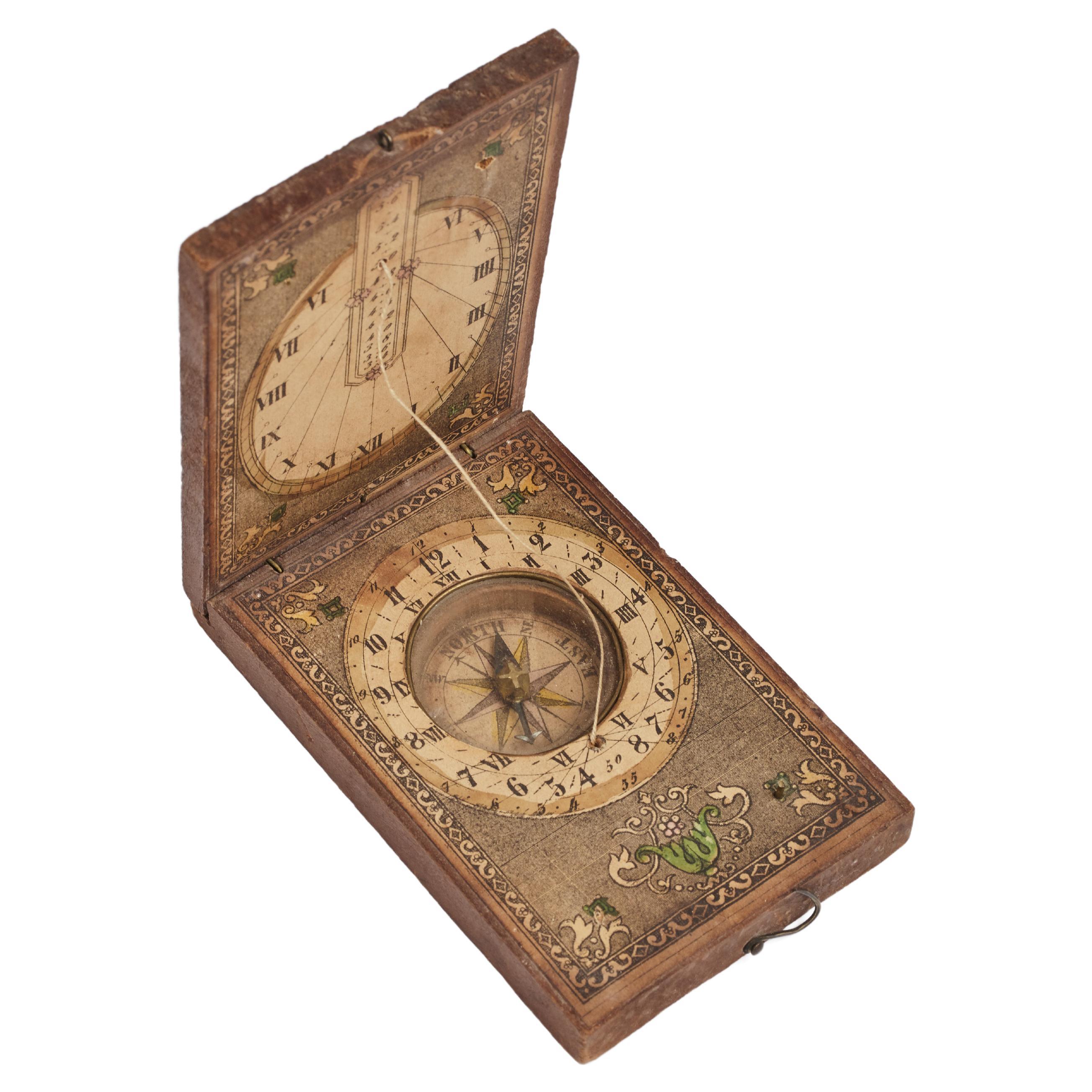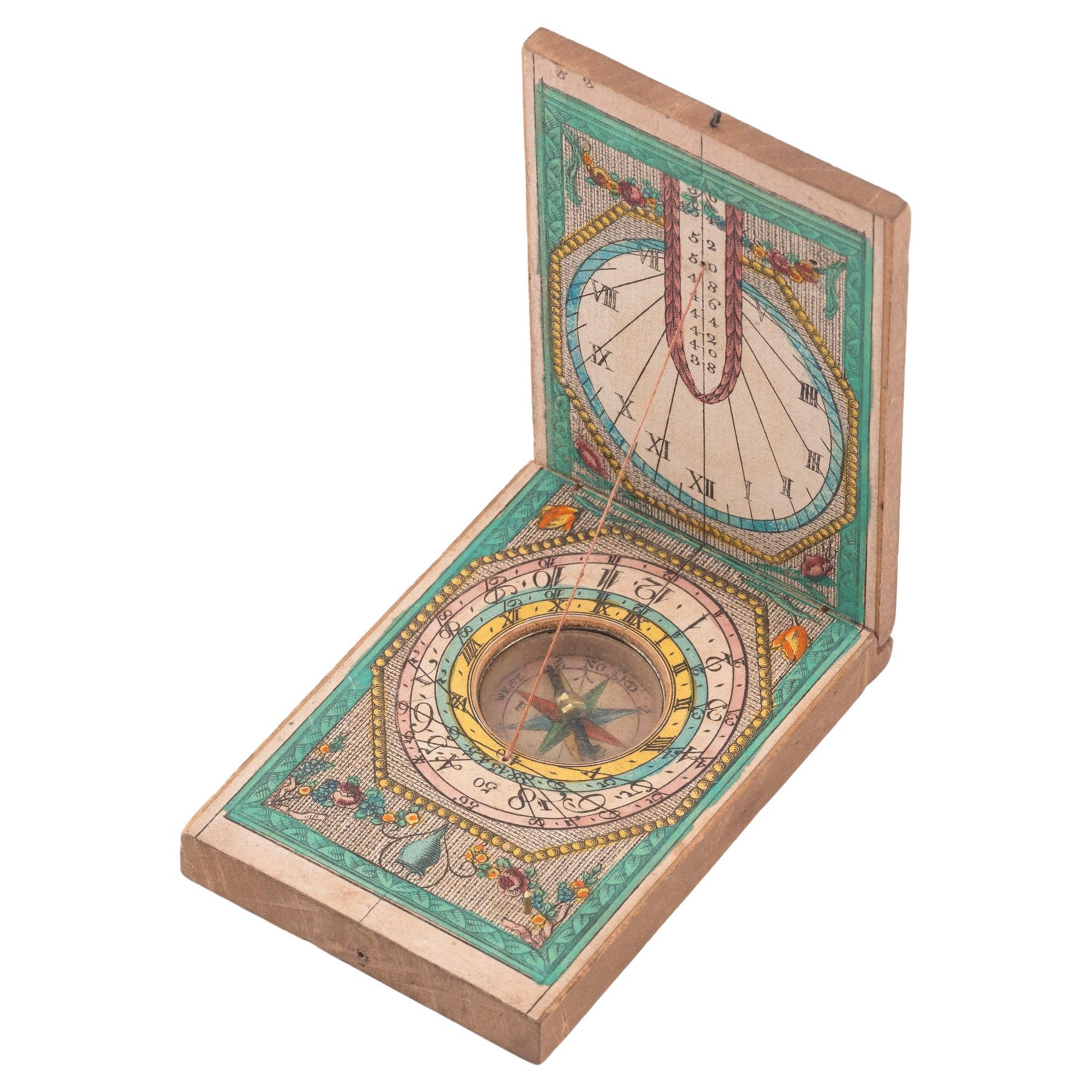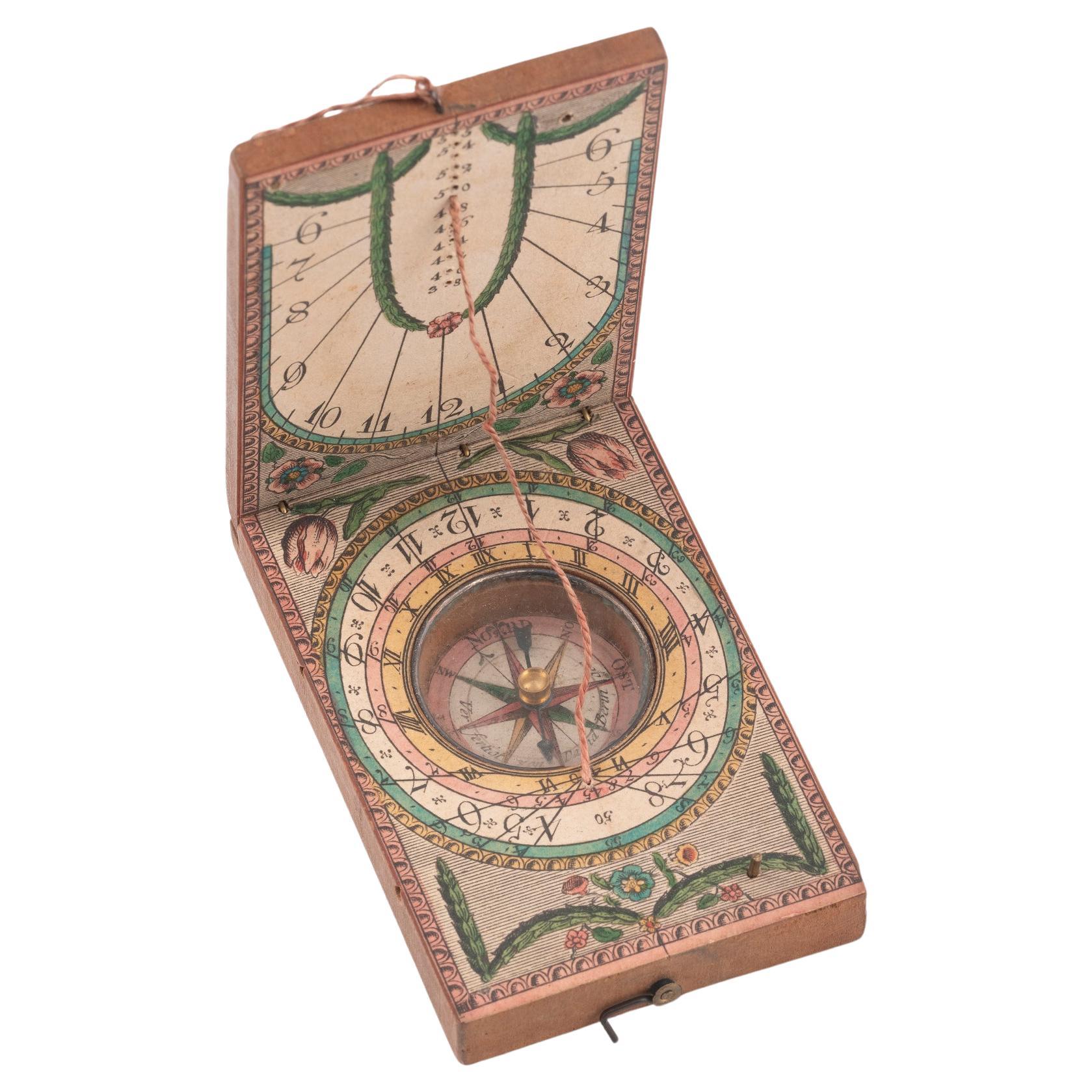Items Similar to Mechanical Equatorial Sundial, Johann Michael Bergauer, Ante 1745
Video Loading
Want more images or videos?
Request additional images or videos from the seller
1 of 19
Mechanical Equatorial Sundial, Johann Michael Bergauer, Ante 1745
About the Item
Johann Michael Bergauer (Simonsfeld, 1676 - Innsbruck, 1745 circa)
Mechanical equatorial sundial
Signed: Michael Bergauer Insprugg? Innsbruck?
Ante 1745
Gilded and silvered brass; glass.
Measures: closed 1.29 x 3.50 x 4.92 in (33 x 89 x 125 mm); open 5.19 x 3.50 x 3.81 in (132 x 89 x 97 mm).
Weight: the sundial 0.49 lb (224 g); the case 0, 20 lb (95 g)
Original wooden case covered in brown leather.
State of conservation: very good. It has some signs of use. The spring that allowed for the two parts of the instrument to remain open is missing (absent even in the comparative specimens kept in museums).
The sundial is composed of two overlapping plates hinged together on the north edge.
The base plate is octagonal and is supported by three turned legs. The upper face is gilded and a compass with a magnetic variation index has been inserted. The rest of the surface is occupied by a rich decoration of engraved scrolls, centered around the inscription “Michael Bergauer Insprugg”. A foldable oval support with a plumb-bob is attached with a hinge on the southern edge. On the reverse of the base plate a table of the latitudes of some European cities (expanded with the vertical writing “Meiland 40” on the edge and “Rome” deleted) and of Jerusalem has been engraved. A Cam marked for 0 °-70 ° is applied near the northern edge. This can be adjusted to change the inclination of the upper plate according to the latitude; originally a spring, now lost, made it possible to keep the two plates of the clock open.
The second plate is round, has a toothed edge and measures 3.26 in (83 mm) in diameter: it is slightly smaller than the octagonal base which it rests upon and overlaps when the instrument is closed.
The recto is gilded and there are three concentric graduated circles engraved on it:
- the outermost is the equatorial hour dial, numbered I-XII, I-XII;
- the second-one is that of days 1-30 of the lunar month and has “Aetas lunae” engraved on it;
- the third, silvered, is a subsidiary hour dial, with double numbering 1-12; originally it could have been rotated.
The engravings of the first two circles are enameled in red.
In the center - on the polar axis - there is an alidade, at the end of which is associated the silvered minute dial. This, in turn, is welded, perpendicularly, to a small disc, also silvered, with a triangular gnomon. The plate, alidade and minute dial are connected to each other by toothed mechanisms.
Below is the procedure for measuring the time:
1) Adjust the Cam under the base of the clock, based on the latitude of your location;
2) Place the watch on a flat surface using the plumb-bob and with the side closest to the compass facing south;
3) Keeping the instrument still, manually rotate the alidade until the shadow cast by the triangular gnomon on the small silvered disc falls on the line marked below it;
4) The hour and minutes can therefore be read on the hour and minute dials set on the alidade respectively.
Johann Michael Bergauer, who sometimes only signs his works as Michael Bergauer, was born in Simonsfeld, north of Vienna. His apprenticeship as a watchmaker took place in Landshut and he probably worked as a laborer in Augsburg before becoming a watchmaker at the court of Karl Philipp von der Pfalz in Innsbruck in 1708. In the following years, his repeated attempts to obtain Innsbruck citizenship are documented and, in 1721, he is listed as a resident. In 1724 he was admitted to the guild of watchmakers, with which however he had continuous problems. In 1732 he presented a "masterpiece". This is the last reference to his business; he must have died before or in 1745 because in that year his widow appealed to the City Council.
The mechanical sundial is compared with very similar examples preserved in:
- The British Museum, 1888, 1201.326;
- The British Museum, reg. no. OA.384;
- Greenwich Maritime Museum, reg. no. AST0469;
- History of Science Museum, Oxford, new inv. no. 51664;
- Germanisches Nationalmuseum, Nuremberg, WI1216;
- National Technical Museum, Praga.
Bibliography:
- Zinner E., Deutsche und Niederländische Astronomische Instrumente des 11.18. Jahrhunderts, Munich, 1979, passim;
- Francis Ward, A catalogue of scientific instruments in the Department of Medieval and later Antiquities of the British Museum, London 1981, s. v;
- Wolfgang, Eckhardt, Claude Dunod, Michael Bergauer und Johann Willebrand – Zur Geschichte der Minutensonnenuhr, Jahrbuch des Museums für Kunst und Gewerbe Hamburg 3, 1984, pp. 79-104;
- Gerard, L'E. Turner; Andrew, Turner, Scientific Instruments, 1500-1900: An Introduction, London 1998, p. 22;
- Higton H., Sundials at Greenwich, Oxford 2002, no. 165, pp. 181-2;
- Abeler J., Meister der Uhrmacherkunst, 2010, p. 59.
- Creator:Johann Michael Bergauer (Maker)
- Dimensions:Height: 1.3 in (3.3 cm)Width: 4.93 in (12.5 cm)Depth: 3.51 in (8.9 cm)
- Style:Baroque (Of the Period)
- Materials and Techniques:
- Place of Origin:
- Period:1730-1739
- Date of Manufacture:circa 1730
- Condition:Very good. It has some signs of use. The spring that allowed for the two parts of the instrument to remain open is missing (absent even in the comparative specimens kept in museums).
- Seller Location:Milano, IT
- Reference Number:1stDibs: LU4352228069592
About the Seller
4.3
Vetted Seller
These experienced sellers undergo a comprehensive evaluation by our team of in-house experts.
Established in 1860
1stDibs seller since 2018
19 sales on 1stDibs
Typical response time: 4 hours
Associations
International Confederation of Art and Antique Dealers' Associations
- ShippingRetrieving quote...Ships From: Milano, Italy
- Return PolicyA return for this item may be initiated within 14 days of delivery.
More From This SellerView All
- Miniature Terrestrial Globe Newton & Son London, Post 1833, Ante 1858By Newton and SonLocated in Milano, ITMiniature Terrestrial Globe Newton & Son London, post 1833, ante 1858 Paper, papier-mâché, bronze and wood It measures: sphere diameter 2.95 in (7.6 cm); diameter of the wooden base 6.02 in (15.3 cm); height 8.36 in (21.24 cm). Weight: 2,067 lb. State of conservation: the globe still bears its original paint, but has various small gaps, abrasions and stains on the surface. The globe is hinged with two pins at the meridian circle, which is in turn inserted perpendicular to the horizon circle; this is supported by four semi-arches connected at the bottom by a small goblet-shaped foot, resting on a wooden bell-shaped base. Apart from the wooden base, the entire support structure is made of bronze; on the foot there are the scale reproductions of a compass, a telescope and an open book. The sphere is made of papier-mâché and is covered with twelve printed paper gores. In the North Pacific Ocean the globe bears a cartouche with the inscription (about 30% of the writing is illegible, but the missing parts can be easily integrated based on the rest): NEWTON’S New & Improved TERRESTRIAL Globe Published by Newton & Son 66 Chancery Lane LONDON On the globe, much of central Africa is empty and the great lakes Tanganyika and Victoria are not marked (Europeans would begin to explore the area after 1858). Canada is called "British Territory" and Alaska "Russian Territory" (it would become part of the United States in 1867). Australia already bears its modern name (until 1829 it had been called New Holland) and its coasts are completely designed; Tasmania is listed as an island (Matthew Flinders circumnavigated it in 1798). The routes of Cook's various voyages are plotted; both the route followed by Biscoe in 1831 and the "Land of Enderby" which he discovered on the coast of Antarctica, south of Africa, are marked. Bibliography P. Van der Krogt, Old Globes...Category
Antique 1840s English Early Victorian Maps
MaterialsBronze
- Pair of Miniature Globes Lane’s on Tripod Bases, London post 1833, ante 1858By Lane'sLocated in Milano, ITPair of miniature globes Lane’s, London, post 1833, ante 1858 Papier-mâché, wood and paper They measure: Height 9.44 in (24 cm); Sphere diameter 2.75 in (7 cm); Diameter of t...Category
Antique 1840s English Early Victorian Maps
MaterialsPaper, Wood
- Ancient Boxwood Micro Carving Deposition, First Half of the 18th CenturyLocated in Milano, ITBoxwood micro carving Deposition Central Europe, first half of the 18th century It measures: the sculpture 7.40 x 5.31 x 0.6 in (18.8 x 13.5 x 1.6 cm); w...Category
Antique 1740s European Baroque Figurative Sculptures
MaterialsBoxwood
- Meissen Porcelain Bear, Johann Gottlieb Kirchner, Johan Joachim Kaendler, 1735By J.J. KaendlerLocated in Milano, ITHard porcelain bear modeled and painted in gray-brown and black Manufacture of Meissen, by Johann Gottlieb Kirchner and Johan Joachim Kaendler, 1735 It...Category
Antique 1730s German Baroque Porcelain
MaterialsPorcelain
- Pair of English 12-inch Globes by William Harris, London, 1832 and 1835By William HarrisLocated in Milano, ITPair of 12-inch table globes William Harris London, 1832 and 1835 Slight abrasions from use; few cracks lb 11 each (kg 5) The two terrestrial and celestial globes rest in their original Dutch style stands with four supporting turned wood columns. Each one measures 12 in in height x 16.5 in in diameter with the diameter of the spheres measuring approximately 12 in; 48 cm in height x 42 cm in diameter x 31 cm diameter of the spheres. The 12 inch measure was the most frequently used by British manufacturers of globes of this period. Each globe is composed of two series of twelve printed paper gores, aligned and glued onto plaster spheres. The brass circle of the meridian bears engravings...Category
Antique 1830s English William IV Globes
MaterialsPaper, Wood
- English Pocket Globe, London, Circa 1775-1798By Herman MollLocated in Milano, ITPocket globe London, between 1775 and 1798 Re-edition of the globe of Hermann Moll (1678-1732) dated 1719 The globe is contained in its original case, which itself is covered in sh...Category
Antique Late 18th Century English George III Globes
MaterialsShagreen, Paper
You May Also Like
- Compass with Pocket Sundial, with Case, Bronze, Butterfield, Michael '1635-1724'Located in Madrid, ESCompass with pocket sundial, with case. Bronze. BUTTERFIELD, Michael (1635-1724). Paris, circa 1700. Pocket sundial made of engraved metal, with a gno...Category
Antique Early 18th Century French Neoclassical Scientific Instruments
MaterialsMetal, Bronze, Other
- 19th Century, Compass and Sundial TogetherLocated in Miami, FL19th century, compass and sundial together.Category
Antique Late 19th Century French Baroque Scientific Instruments
MaterialsWood
- 19th Century Compass and Sundial TogetherLocated in Miami, FL19th century compass and sundial together.Category
Antique Late 19th Century French Baroque Scientific Instruments
MaterialsWood
- A wooden diptical sundial, England 1790.Located in Milan, ITPocket sundial, made out of wood, with print paper element on both the internal sides and to the top. England end of XVIII cent.Category
Antique Late 18th Century English Scientific Instruments
MaterialsWood, Paper
- A Wooden Diptical Sundial Germany 1810'sLocated in Firenze, ITSHIPPING POLICY: No additional costs will be added to this order. Shipping costs will be totally covered by the seller (customs duties included). Pocket sundial, made out of wood, ...Category
Antique 1810s German Neoclassical Scientific Instruments
MaterialsPaper
- A Wooden Diptical Sundial Germany 1790Located in Firenze, ITSHIPPING POLICY: No additional costs will be added to this order. Shipping costs will be totally covered by the seller (customs duties included). Pocket sundial, made out of wood, ...Category
Antique Late 18th Century German Neoclassical Scientific Instruments
MaterialsPaper
Recently Viewed
View AllMore Ways To Browse
Mechanical Furniture
Antique Mechanical
Engraved Sign Brass
Antique Red End Table
Dior Clock
Antique Watchmaker
Original Signed Document
Dior Magnetic
Karl Springer Brass And Glass
70s Face
Antique Brass H Hinges
Antique Watch London
Brown Face Watch
Antique Brass Watch
Vertical Antique Sign
Karl Springer Signed Table
Austrian Baroque Furniture
Karl Springer Brass Glass Table





